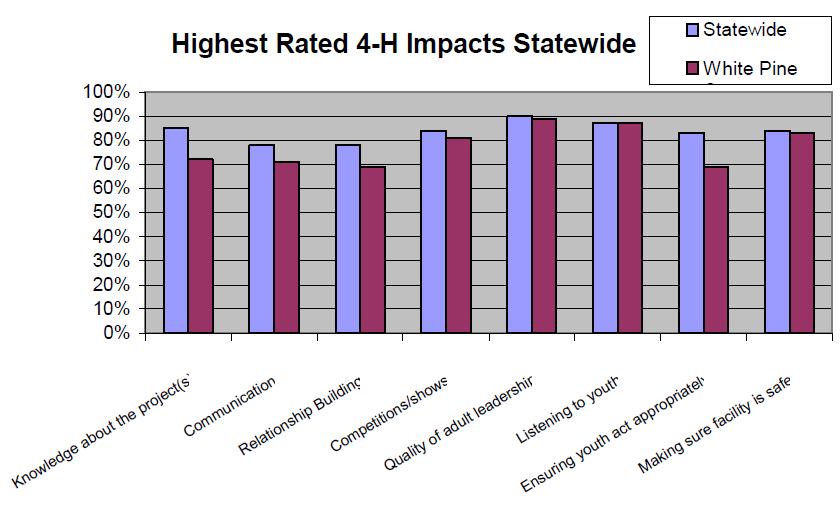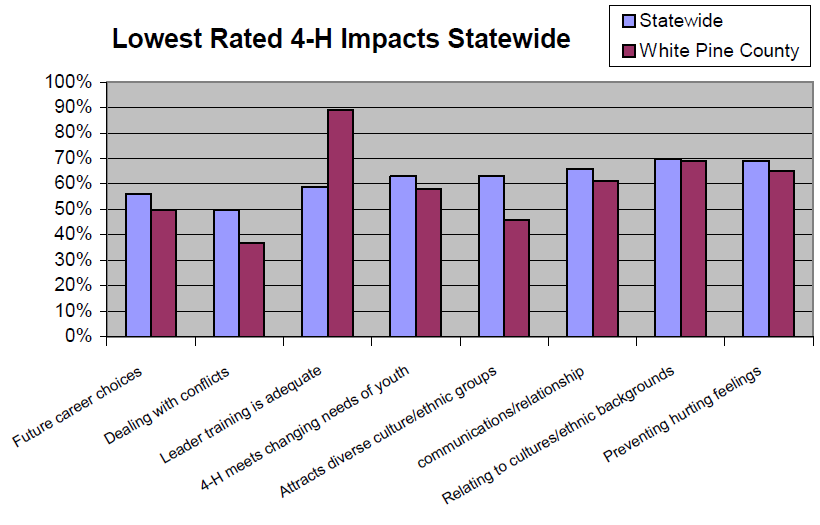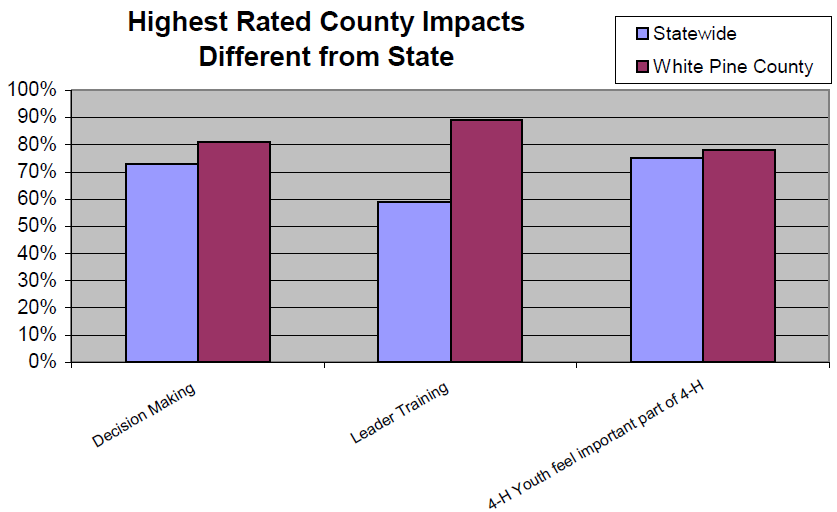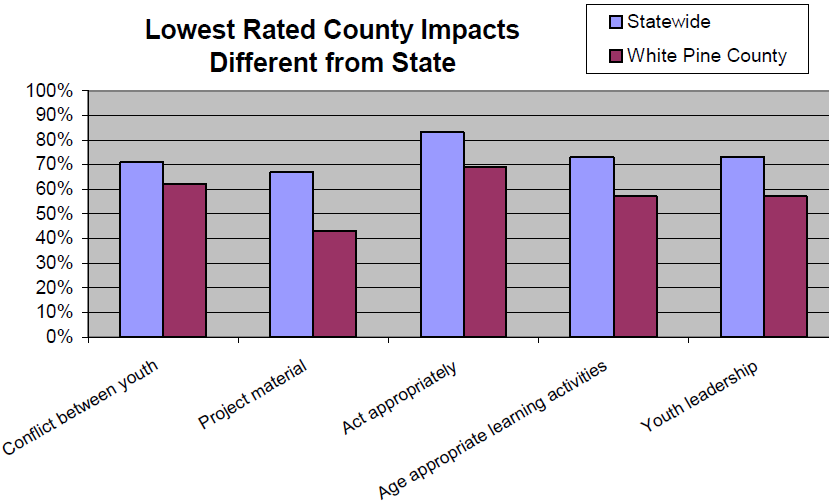Introduction
In continued efforts to assess 4-H program impacts, University of Nevada, Reno, Extension surveyed all 4-H parents and leaders statewide in 2003. The results are being reported statewide and by county. Understanding program impacts at the county level is important because Nevada’s 4-H programs are managed at the county level. This fact sheet reports the impact assessment results statewide, highlighting White Pine County. The purpose of this report is to inform 4-H parents, leaders and youth members how 4-H impacts their lives, and also assist 4-H professionals to develop an action plan to further strengthen White Pine County 4-H.
Designing and Conducting the Assessment
In designing a tool to assess 4-H program impacts, we used two models for youth development. The first model focuses on six desired outcomes from successful youth development. These outcomes are confidence, competence, caring, connection, contributing, and character (Blyth, 2000).
Successful youth development helps children become: confident they can make a difference; competent through their ability, skills, and knowledge, and; able to work with people in a way that develops and promotes caring relationships. These youth connect beneficially with people and organizations, contribute their services to make a difference in their personal development, as well as in their community, and demonstrate responsible and honest character, or a sense of who they are.
The second model for youth development focuses on “core concepts” that provide the basis for successful youth development programs (UNCE, 1993). These programs help develop youth who:
- learn and practice self-responsibility and social responsibility to feel accountable and in control of their lives;
- recognize when and how to make informed decisions and implement decisions to solve a problem or achieve goals;
- communicate effectively in both verbal and written form, to share thoughts and feelings which increases social competence, and;
- obtain career and occupational information to help prepare for the world of work.
Questions developed for this assessment were based on the six desired outcomes of positive youth development and Nevada’s “core concepts” for teaching life skills. The combined models resulted in nine questions to assess the effectiveness of 4-H in teaching youth life skills and six questions to assess social skills youth learn; six questions to measure the effectiveness of traditional 4-H teaching tools and; four questions to assess the efficacy of program management goals.
An additional 18 questions were developed to assess parent and volunteer leadership skills to teach youth, manage 4-H programs and prevent negative and high-risk behavior among 4-H youth. These questions were based on skills established by the National Committee on Community Programs to Promote Youth Development (Eccles and Appleton-Gootman, 2002). These questions were designed to assess the indirect impacts of Nevada 4-H programs on parents and volunteer leaders.
Assessment participants included all parents of 4-H members and adult volunteer 4- H leaders currently enrolled in White Pine County. These participants were selected based on the rationale that 4-H leaders and parents of 4-Hers are those who are most likely to observe any changes that occur among youth participating in 4-H programs.
Each participant received in the mail a two-page questionnaire with instructions, and a self-addressed and stamped return envelope. Also included was a cover letter that explained the purpose of the survey, ensured confidentiality to participants, and thanked them for their participation. Of the 3,074 survey recipients, 576 returned completed questionnaires for a 19 percent response rate.
White Pine County and Statewide Impacts
On a scale of 1 to 5 with “1” being “very low” and “5” being “very high,” respondents were asked to circle the number that best indicates how effectively 4-H is developing youth and impacting adults involved. The results are presented by the highest and lowest ratings. Results for White Pine County are presented with statewide impacts, for comparison purposes.
The highest rated statewide impacts compared to White Pine County are illustrated in Figure 1. The lowest rated statewide impacts compared to White County are illustrated in Figure 2. Individual questions are listed below each set of bars to specify and illustrate the percentage responses for each question. In contrast, Figure 3 features highest rated impacts different for White Pine County as compared with statewide results. Similarly, Figure 4 features areas to target for improvement in White Pine County.
There were 3 major differences in the highest rated impacts for White Pine County as shown in Figure 3. According to the assessment results the top life skill White Pine County youth learn is improved decision-making ability. The highest rated social skill youth learn is improved communication and relationship building. In terms of the efficacy of 4-H teaching and program management goals, the highest rated impact in White Pine County is volunteer leader training adequately provides skills needed to lead 4-H projects. For 4-H parents and volunteer leaders, the highest rated parent and leader teaching skill is listening to youth; program management skill is help 4-H youth feel an important part of 4-H; and prevention skill is making sure that the facility where 4-H meetings are held is safe.
Figure 4 illustrates areas to target for improvement in White Pine County 4-H. According to the assessment results, the lowest rated life skill White Pine County youth learn is about future career choices. The lowest rated social skill youth learn is skills useful in dealing with conflicts. In terms of 4-H teaching and program management goals, the lowest rated impact in White Pine County is 4- H project materials help 4-H youth to gain knowledge and skills related to a project. Teach useful information. For 4-H parents and volunteer leaders, the lowest rated parent and leader teaching skill is providing age appropriate learning activities and youth leadership opportunities; program management skill is 4-H meets the changing needs of youth and attracts diverse cultures and ethnic group. The lowest rated youth risk prevention skill is managing conflict between youth.
Figure 1

Data From Figure 1
Figure 2

Data From Figure 2
Figure 3

Data From Figure 3
Figure 4

Data From Figure 4
Developing an Action Plan to Strengthen White Pine County 4-H
To develop an action plan, White Pine 4-H professionals combined assessment results with available demographic information from White Pine County (see Table 1). Next, we listed a number of 4-H program conditions that describe the current situation in White Pine County. These include the following elements:
- It appears that we are on target in our highest rated impacts. Our highest rated life skill impact is decision making. However, we need to focus our teaching efforts to strengthen youth social skills, such as communication and relationship building.
- White Pine County has prioritized volunteer leader training for the past ten years, and we believe our volunteer middle management programs play an important role in our program management goal. Part of that training has emphasized training leaders to listen to 4-H youth and help them feel an important part of 4-H programs. Parents and Leaders also act as program supervisors in their leadership roles, for instance, making certain the facilities where 4-H meets are as safe as possible.
- The assessment targets areas to improve. These include: teach youth about future career choices; help youth learn how to deal with conflict; help leaders develop age-appropriate learning activities and youth leadership programs; meet the changing needs of youth; attract diverse and ethnic groups to 4- H, and; train volunteer leaders and parents how to best deal with conflict among 4-H youth.
Considering both impact assessment results and current conditions of White Pine 4- H, the planning team decided in order to impact more youth, and yet continue to have high impacts overall, any strategy to strengthen 4-H must continue to move 4-H in a positive focused direction.
Since conflict in White Pine County 4-H consumes a lot of professional staff time and energy, a top priority for program direction that emerged from the planning process is to enhance life skills useful in dealing with conflicts. This skill was identified also as one of the lowest rated impacts countywide. Thus, the action plan for White Pine 4-H includes the following three objectives:
- Identify state and area specialists that are willing and interested in working with White Pine 4-H staff to strengthen 4-H programs to teach life skills useful in managing and resolving conflict.
- Work with state and area “conflict resolution team” to develop a plan to determine the best way to approach this program area and how to best include 4- H youth in the planning process.
- Seek conflict resolution training and curriculum materials that show the greatest promise for 4-H program applications.
Table 1. White Pine County Demographics
| Category |
Amount |
| Number of school-age children in White Pine County |
1,435 |
| Total number of 4-H youth in White Pine County |
211 |
| Largest ethnic group of public school enrollment in White Pine County |
82% White |
| Ethnic distribution of 4-H youth in White Pine County |
93% White |
| Median income of families in White Pine County |
$55,000 |
| Most 4-H families in White Pine County earn annually |
$50,000 - $74,999 |
| Percent 4-H families in White Pine County earning below $25,000 annually |
8.6% |
| Percent of families in White Pine County earning below $25,000 |
7.3 % |
Conclusions
This fact sheet reported the results of the 2003 Extension 4-H impact assessment comparing highest and lowest impacts for White Pine County with Statewide results. According to the assessment results the top life skill White Pine County youth learn is improved decision-making. The highest rated social skill youth learn is improved communication and relationship building. In terms of 4-H teaching and program management goals, the highest rated impacts in White Pine County are volunteer leader training adequately provides skills needed to lead 4-H projects. For 4-H parents and volunteer leaders, the highest rated parent and leader teaching skill is listening to youth; program management skill is help 4-H youth feel an important part of 4-H; and prevention skill is making sure 4-H facility is safe.
The lowest rated life skill White Pine County youth learn is learning about future career choices. The lowest rated social skill youth learn is dealing with conflicts. In terms of 4-H teaching and program management goals, the lowest rated impact in White Pine County is 4- H project materials help 4-H youth gain knowledge and skills related to a project. For 4-H parents and volunteer leaders, the lowest rated parent and leader teaching skill providing 4-H youth with age is appropriate learning activities and youth leadership programs; program management skill is meeting the changing needs of youth and attracting diverse cultures and ethnic groups. The lowest prevention skill is managing conflicts between youth.
Considering both impact assessment results and current conditions of White Pine 4- H, the planning team decided in order to positively impact more youth, and yet continue to have high impacts overall, any strategy to strengthen 4-H must continue to move 4-H in a positive focused direction. Since conflict in White Pine County 4-H consumes a lot of professional staff time and energy, a top priority for program direction that emerged from the planning process is to enhance life skills useful in dealing with conflicts.
Efforts are currently underway to develop action plans for most county 4-H programs in Nevada. The resulting action plans will serve as guidelines for strengthening 4-H in a positive, objective manner, and to continue to generate new ways in which 4-H can make the best better.
References
- Blyth, D. 2000. “Extension’s Roles in Community Youth Development for the 21rst Century,” The Center. Communication and Educational Technology Services, University of Minnesota Extension Service.
- Singletary, L. and M. Smith. 2004. Nevada 4-H Statewide Impact Assessment. Extension Bulletin. EB-04-01. Reno, NV: University of Nevada Cooperative Extension.
- University of Nevada Cooperative Extension. 1993. Youth Development in Nevada, Core Concepts: A Framework for Programming. Tri-fold Brochure.
Figure 1. Highest Rated 4-H Impacts Statewide
| Category |
Statewide |
White Pine |
| Knowledge about the project(s) |
85% |
72% |
| Communication |
79% |
71% |
| Relationship Building |
78% |
69% |
| Competitions/shows |
84% |
81% |
| Quality of adult leadership |
90% |
89% |
| Listening to youth |
87% |
87% |
| Ensuring youth act appropriately |
83% |
69% |
| Making sure facility is safe |
84% |
83% |
Figure 2. Lowest Rated 4-H Impacts Statewide
| Category |
Statewide |
White Pine |
| Future career choices |
56% |
50% |
| Dealing with conflicts |
50% |
37% |
| Leader training is adequate |
59% |
89% |
| 4-H meets changing needs of youth |
63% |
58% |
| Attracts diverse culture/ethnic groups |
63% |
46% |
| communications/relationship |
66% |
61% |
| Relating to cultures/ethnic backgrounds |
70% |
69% |
| Preventing hurting feelings |
69% |
65% |
Figure 3. Highest Rated County Impacts Different from State
| Category |
Statewide |
White Pine |
| Decision Making |
72% |
81% |
| Leader Training |
59% |
89% |
| 4-H Youth feel important part of 4-H |
75% |
79% |
Figure 4. Lowest Rated County Impacts Different from State
| Category |
Statewide |
White Pine |
| Conflict between youth |
71% |
61% |
| Project material |
67% |
43% |
| Act appropriately |
82% |
69% |
| Age appropriate learning activities |
73% |
57% |
| Youth leadership |
73% |
57% |


